Malchus, servant healed by Jesus after Peter's attack, finds his fate intertwined with a lesson of compassion, leaving history pondering his subsequent path.
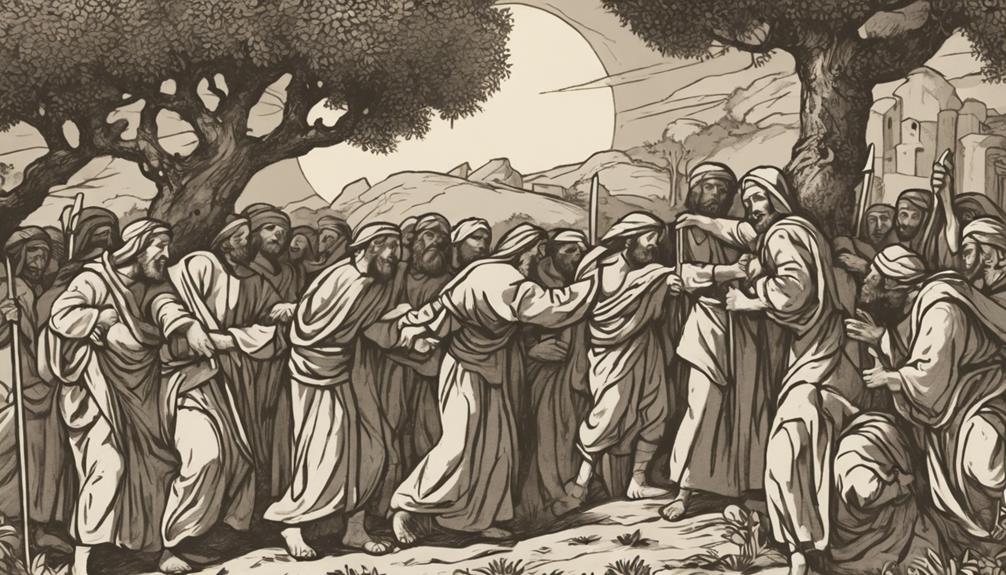
What Happened to Malchus in the Bible
Imagine you're scrolling through your social media feed and stumble across a post about a high-drama incident from ancient times, featuring a clash in the Garden of Gethsemane.
You're about to uncover the story of Malchus, a servant who found himself on the business end of Peter's sword during a tense encounter. However, the narrative takes a surprising turn with Jesus' compassionate intervention. This moment not only showcases a miraculous healing but also serves as a profound lesson in forgiveness.
But what happened next to Malchus, and how does this event echo through history? Your curiosity might just lead you to uncover the layers of this intriguing episode.
Key Takeaways
- Malchus was a servant of the high priest whose ear was cut off by Peter in the Garden of Gethsemane.
- Jesus immediately healed Malchus' ear, showcasing divine compassion and authority.
- The incident exemplifies forgiveness and mercy, even in the face of betrayal and violence.
- Malchus' healing serves as a symbol of reconciliation and divine love during a moment of conflict.
The Garden of Gethsemane
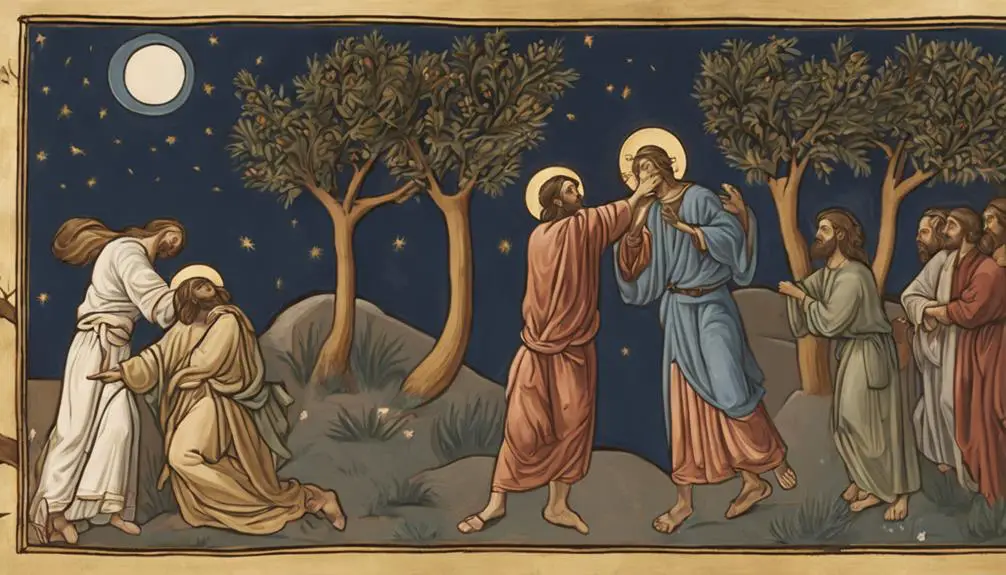
In the Garden of Gethsemane, a pivotal event unfolded that set the stage for the subsequent arrest of Jesus, an event witnessed by his disciples, including the figure of Malchus. This garden, known for its olive groves, carries deep symbolic meaning, especially considering the olive press's significance. In biblical times, the process of pressing olives was associated with hardship and suffering, mirroring Jesus' agony as he prayed.
The context of the night arrest further amplifies the gravity of the moment. Arrests during this period weren't uncommon, yet the timing and setting of this particular apprehension underscore a deliberate breach of traditional legal protocols, which typically eschewed nocturnal operations. This deviation from normative practices highlights the clandestine and urgent nature of Jesus' arrest, underscoring the authorities' determination to avoid public spectacle or uprising.
Understanding the setting and circumstances of the Garden of Gethsemane provides crucial insight into the narrative's unfolding and its theological implications. It was here that the initial steps toward the culmination of Jesus' earthly ministry were taken, deeply entwined with symbols of sacrifice and surrender, a testimony to the profound events that were to follow.
Peter's Rash Action
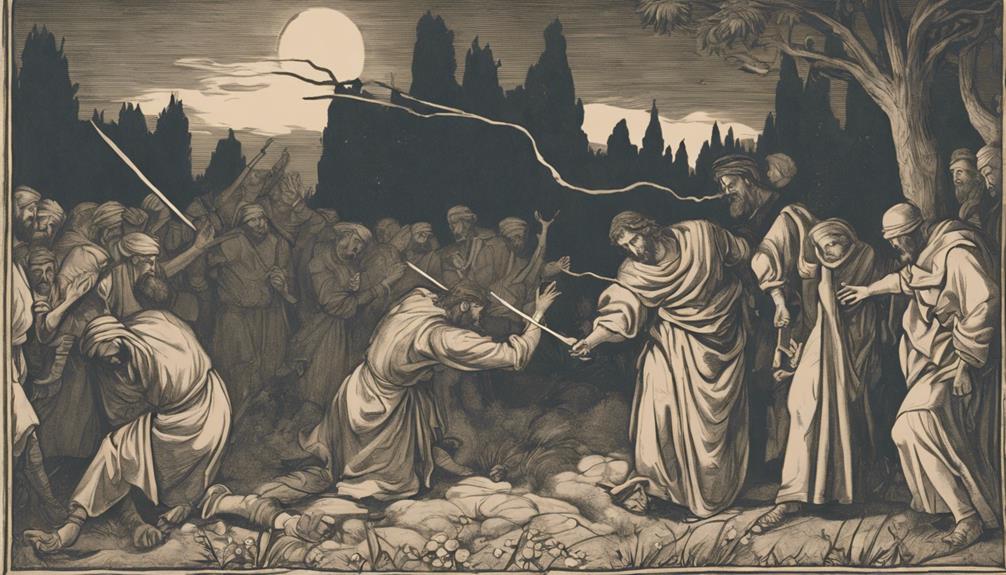
Amid the tension-filled atmosphere of the Garden of Gethsemane, Peter's impulsive action against Malchus marks a critical moment of discord and violence. This incident not only showcases the immediate reaction of a disciple under threat but also serves as a pivot around which the narrative of loyalty and fear unfolds.
- Sword Symbolism: Peter's decision to draw his sword represents more than just a physical act of aggression. It symbolizes the disciple's struggle to comprehend the spiritual kingdom Jesus spoke of, mistaking it for a call to earthly warfare. This misunderstanding highlights the chasm between Jesus' teachings and the disciple's expectations.
- Disciple's Fear: The act can be seen as a manifestation of fear rather than faith. Faced with the imminent capture of their leader, the disciples' human instinct for fight or flight surfaced, with Peter choosing the former in a desperate attempt to protect Jesus and perhaps, their collective hope.
- Immediate Reaction: Peter's response was spontaneous, reflecting neither strategic nor spiritual guidance. It was a raw, unfiltered human reaction to a perceived threat, underscoring his vulnerability and impulsiveness.
- Moment of Discord: This incident ruptures the night's somber anticipation, propelling the narrative into a confrontation that would lead to profound consequences for all involved. Peter's rashness serves as a catalyst, exacerbating the situation beyond a point of peaceful resolution.
Jesus' Compassionate Response
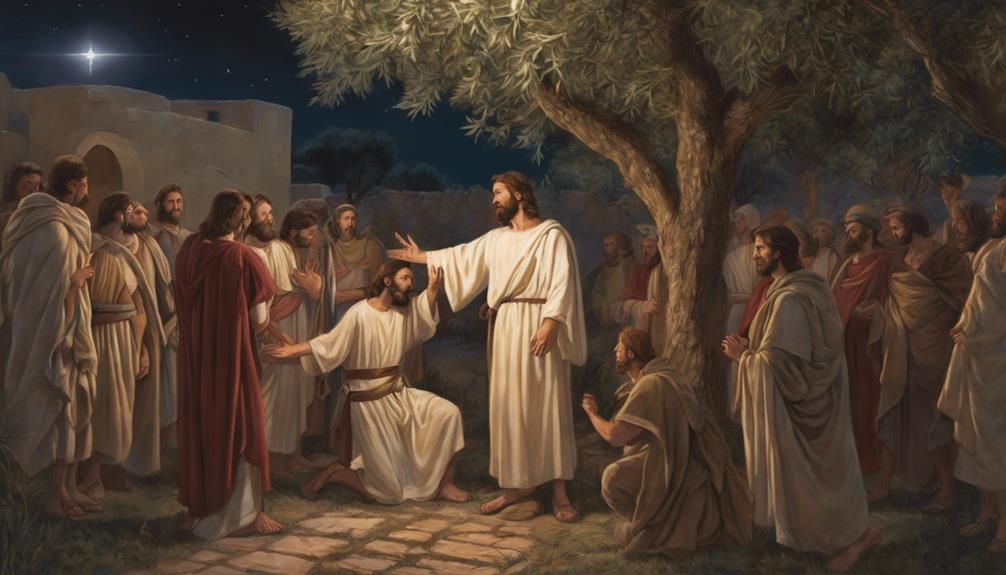
Following Peter's aggressive act, Jesus' response showcased an unparalleled level of compassion, immediately addressing the chaos with a healing touch. This moment of divine empathy, set against the arrest context, provides a profound insight into the character of Jesus and his mission. The arrest context, inherently fraught with tension and fear, typically wouldn't engender a moment of healing or compassion. Yet, in this instance, Jesus transcends the immediate threat to his own safety to address the injury inflicted upon Malchus, an adversary's servant.
This act of compassion isn't merely a response to physical harm but a demonstration of a deeper, divine empathy. Jesus' reaction to Peter's violence, juxtaposed with the imminent threat of his arrest, underscores a commitment to healing and peace even in moments of personal crisis. It's indicative of his teaching that love and compassion should extend beyond friend and follower to include those perceived as enemies.
Analyzing this response within the arrest context highlights Jesus' consistent application of his teachings, even in the face of adversity. This episode serves as a testament to his unwavering dedication to compassion, showcasing how divine empathy transcends human conflict.
The Miracle of Healing

Reflecting on Jesus' compassionate response, we now explore the miracle of healing performed on Malchus, highlighting its significance in the broader context of his teachings. This event, marked by divine intervention, stands out as one of the New Testament's most poignant miraculous occurrences.
The following list elucidates key aspects of this event:
- Immediate Healing: Jesus' action to heal Malchus' severed ear underscores the immediacy and completeness of divine healing. Unlike natural healing processes, this miracle required no medical intervention, emphasizing the supernatural power at play.
- Public Display: Performed in front of multiple witnesses, this act not only demonstrated Jesus' divine authority but also served as a testament to his teachings on compassion and non-violence, even in the face of betrayal and arrest.
- Symbolic Gesture: The healing can be interpreted as a symbolic act of reconciliation. In a moment charged with conflict and aggression, it offered a counter-narrative of peace and forgiveness.
- Teaching Moment: Beyond the physical healing, this event provided a crucial teaching moment for both Jesus' disciples and his adversaries. It reinforced the message that divine intervention and miraculous occurrences are manifestations of a higher law of love and healing, transcending human conflict and violence.
Reflections on Forgiveness

In examining the healing of Malchus, one can't overlook the profound implications for understanding forgiveness within the context of Jesus' teachings. This act, performed in the face of betrayal and violence, epitomizes the embodiment of divine mercy, juxtaposed starkly against human frailty. It's not merely a healing of physical wounds but a profound demonstration of the power and necessity of forgiveness.
The incident serves as a critical lens through which to scrutinize the dynamics of forgiveness, highlighting its role not as an optional virtue but as a fundamental pillar of spiritual and ethical living. It illustrates that forgiveness transcends the human inclination towards retribution, emphasizing instead a call to embody a grace that mirrors divine mercy.
This narrative invites you to consider forgiveness not as a passive act but as an active choice, a deliberate movement towards reconciliation and healing. It underscores the belief that forgiveness, rooted in an understanding of both divine mercy and human frailty, is essential for genuine transformation and growth. Through this lens, the story of Malchus becomes a compelling call to embrace forgiveness as a radical act of love and a testament to the strength of the human spirit.
Frequently Asked Questions
How Does the Story of Malchus Challenge Traditional Views on Authority and Power in Biblical Narratives?
The story you're delving into flips traditional views on their heads, showcasing a striking authority inversion. It's not just about who holds power; it's how they wield it.
This narrative pushes you to rethink leadership, highlighting the potency of servant leadership in places you'd least expect. It challenges the norm, asking you to consider the impact of compassion and service over dominance, reshaping your understanding of authority in biblical stories.
In What Ways Has the Story of Malchus Been Interpreted in Different Christian Denominations, and What Theological Implications Does This Have?
You're delving into how different Christian denominations have uniquely interpreted Malchus' story, highlighting denominational differences and theological interpretations. This exploration reveals significant variances in understanding authority, mercy, and divine intervention.
It's crucial to recognize these perspectives not only shape theological discourse but also influence believers' views on compassion and justice. By analyzing these diverse interpretations, you're uncovering the broader theological implications that enrich our grasp of biblical narratives.
Are There Any Historical Records or Archaeological Findings That Corroborate the Account of Malchus' Encounter With Jesus and Peter Outside Biblical Texts?
You're looking for historical or archaeological evidence outside the Bible to verify the encounter involving Malchus. Unfortunately, there aren't any ancient manuscripts or archaeological discoveries that directly corroborate this specific event.
The earliest accounts of this incident are found within the biblical texts themselves. Scholars often rely on these texts and historical context to analyze the plausibility of such events, but external confirmations remain elusive.
How Has the Character of Malchus Been Represented in Christian Art and Literature Throughout History, and What Symbolism Is Often Associated With Him?
In artistic depictions and literary interpretations, you'll find Malchus symbolizing themes of mercy and transformation. Historically, artists and authors have portrayed him in various lights, often focusing on the moment of his encounter, which is rich in symbolic meaning.
This representation serves as a powerful narrative tool, highlighting the grace and forgiveness inherent in the story. Through these mediums, Malchus's story has been a source of inspiration and reflection across centuries.
What Role Does the Story of Malchus Play in Contemporary Christian Discussions on Non-Violence and Peacemaking?
In contemporary Christian discussions on non-violence and peacemaking, the story of Malchus serves as a powerful example. It highlights the importance of healing miracles and forgiveness symbolism, urging you to embrace empathy and reconciliation over retaliation.
Conclusion
In analyzing the episode involving Malchus, it's evident that this narrative extends beyond a mere miraculous healing.
Jesus' intervention, following Peter's impulsive act, underscores a profound teaching on non-violence and mercy.
The restoration of Malchus' ear symbolizes not only Christ's healing power but also his emphasis on forgiveness and reconciliation.
This incident, therefore, enriches our understanding of Jesus' teachings, highlighting the depth of his compassion and the significance of forgiveness in human interactions.


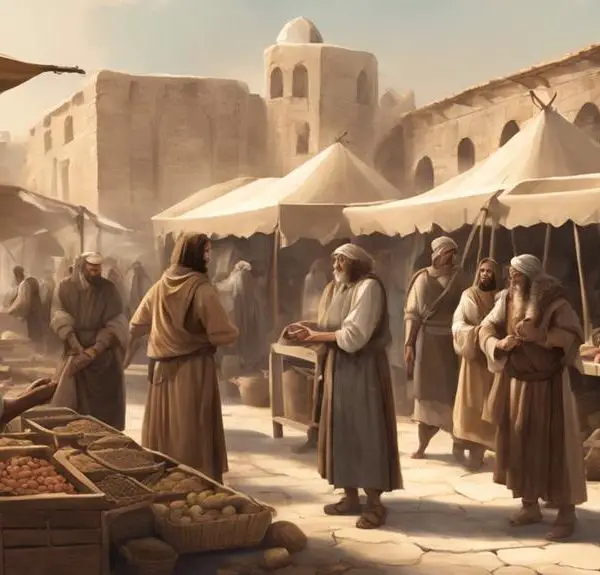
Sign up